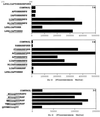Identification of immunodominant T cell epitopes of human glutamic acid decarboxylase 65 by using HLA-DR(alpha1*0101,beta1*0401) transgenic mice
- PMID: 9223318
- PMCID: PMC21560
- DOI: 10.1073/pnas.94.15.8082
Identification of immunodominant T cell epitopes of human glutamic acid decarboxylase 65 by using HLA-DR(alpha1*0101,beta1*0401) transgenic mice
Abstract
Glutamic acid decarboxylase isoform 2 (GAD65; EC 4.1.1.15) has been identified as a key target autoantigen of insulin-dependent diabetes mellitus (IDDM). IDDM is genetically associated with the major histocompatibility complex (MHC), and particular alleles from the HLA-DQ and HLA-DR loci contribute to disease. Among DR4 subtypes, HLA-DRB1*0401, HLA-DRB1*0402, and HLA-DRB1*0405 alleles lend susceptibility, while HLA-DRB1*0403 confers protection. We have utilized HLA-DR(alpha1*0101,beta1*0401) (hereafter referred to as DR0401), human CD4, murine class II null triple transgenic mice and recombinant GAD65 to generate T cell hybridomas, and we have used overlapping sets of peptides to map the immunodominant epitopes of this autoantigen. We have identified 10 immunogenic regions for GAD65, of which 6 are recognized by multiple hybridomas. These epitopes are also generated by human antigen-presenting cells and their presentation is DR0401 restricted, as shown by the use of typed human lymphoblastoid cell lines and antibody blocking experiments. Immunodominant GAD65 epitopes defined in transgenic mice correspond to GAD65 regions previously shown to elicit T cell responses specifically in DR0401 IDDM patients, underscoring the validity of this approach. Interestingly, although the major epitopes contain DR0401 binding motifs, one of the epitopes contains a DR0405 motif.
Figures




Similar articles
-
Major DQ8-restricted T-cell epitopes for human GAD65 mapped using human CD4, DQA1*0301, DQB1*0302 transgenic IA(null) NOD mice.Diabetes. 1999 Mar;48(3):469-77. doi: 10.2337/diabetes.48.3.469. Diabetes. 1999. PMID: 10078545
-
Identification of naturally processed T cell epitopes from glutamic acid decarboxylase presented in the context of HLA-DR alleles by T lymphocytes of recent onset IDDM patients.J Clin Invest. 1997 May 15;99(10):2405-15. doi: 10.1172/JCI119423. J Clin Invest. 1997. PMID: 9153283 Free PMC article.
-
Naturally processed T cell epitopes from human glutamic acid decarboxylase identified using mice transgenic for the type 1 diabetes-associated human MHC class II allele, DRB1*0401.J Clin Invest. 1996 Dec 1;98(11):2597-603. doi: 10.1172/JCI119079. J Clin Invest. 1996. PMID: 8958223 Free PMC article.
-
T cell defined HLA epitopes and T cell receptor polymorphism in insulin dependent diabetes mellitus.Baillieres Clin Endocrinol Metab. 1991 Jun;5(2):341-55. doi: 10.1016/s0950-351x(05)80131-4. Baillieres Clin Endocrinol Metab. 1991. PMID: 1716435 Review.
-
Identification of autoantigen epitopes in MHC class II transgenic mice.Immunol Rev. 1998 Aug;164:129-38. doi: 10.1111/j.1600-065x.1998.tb01215.x. Immunol Rev. 1998. PMID: 9795771 Review.
Cited by
-
Age-dependent loss of tolerance to an immunodominant epitope of glutamic acid decarboxylase in diabetic-prone RIP-B7/DR4 mice.Clin Immunol. 2006 Dec;121(3):294-304. doi: 10.1016/j.clim.2006.08.002. Epub 2006 Sep 18. Clin Immunol. 2006. PMID: 16979383 Free PMC article.
-
Peripheral blood mononuclear cells reactivity in recent-onset type I diabetes patients is directed against the leader peptide of preproinsulin, GAD65271-285 and GAD65431-450.Front Immunol. 2023 Mar 9;14:1130019. doi: 10.3389/fimmu.2023.1130019. eCollection 2023. Front Immunol. 2023. PMID: 36969220 Free PMC article.
-
Evaluating candidate autoantigens in rheumatoid arthritis.Springer Semin Immunopathol. 1998;20(1-2):23-39. doi: 10.1007/BF00831997. Springer Semin Immunopathol. 1998. PMID: 9836367 No abstract available.
-
T cell response pattern to glutamic acid decarboxylase 65 (GAD65) peptides of newly diagnosed type 1 diabetic patients sharing susceptible HLA haplotypes.Clin Exp Immunol. 1999 Jul;117(1):30-7. doi: 10.1046/j.1365-2249.1999.00945.x. Clin Exp Immunol. 1999. PMID: 10403912 Free PMC article.
-
Autoreactive human T-cell receptor initiates insulitis and impaired glucose tolerance in HLA DR4 transgenic mice.J Autoimmun. 2008 Jun;30(4):197-206. doi: 10.1016/j.jaut.2007.08.001. Epub 2007 Oct 18. J Autoimmun. 2008. PMID: 17949947 Free PMC article.
References
-
- Todd J A, Bell J I, McDevitt H O. Nature (London) 1987;329:599–604. - PubMed
-
- Nepom G T, Erlich H. Annu Rev Immunol. 1991;9:493–525. - PubMed
-
- Erlich H A, Zeidler A, Chang J, Shaw S, Raffel L J, Klitz W, Bashkov Y, Costin G, Pressmann S, Bugawan T, Rotter J I. Nat Genet. 1993;3:358–363. - PubMed
-
- Cucca F, Lampis R, Frau F, Macis D, Angius E, Masile P, Chessa M, Frongia P, Silvetti M, Cao A, De Virgilis S, Congia M. Hum Immunol. 1995;43:301–308. - PubMed
-
- Van der Auwera B, Van Waeyenberge C, Schuit F, Heimberg H, Vandewalle C, Gorus F, Flament J. Diabetes. 1995;44:527–530. - PubMed
Publication types
MeSH terms
Substances
Grants and funding
LinkOut - more resources
Full Text Sources
Other Literature Sources
Medical
Research Materials

